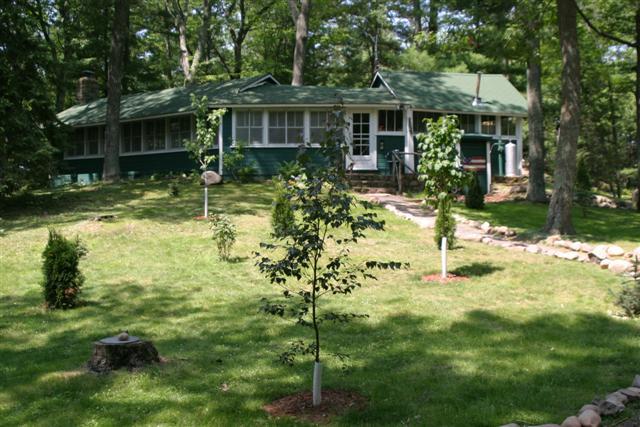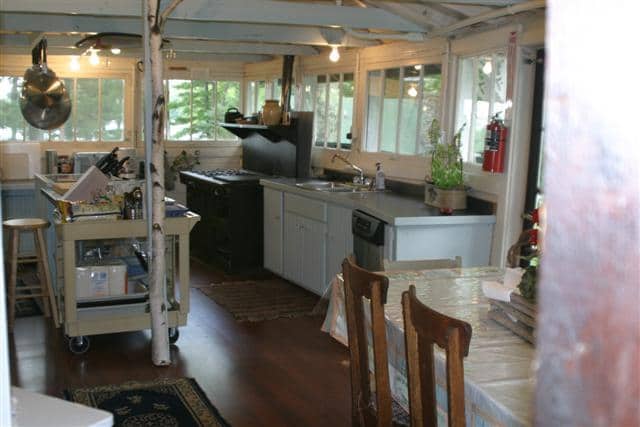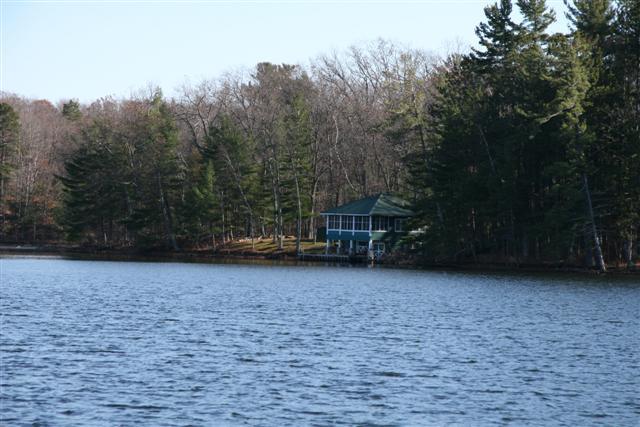Memories of growing up on the Isle of Pines on Lake Little Sissabagama
By Ted Crandall, as told to Peter Lytle. Submitted by Connie Schield, Stone Lake Area Historical Society.
My parents, Walter and Mary Crandall, were the caretakers of a private fishing camp on a seven acre heavily wooded island on Lake Little Sissabagama in Sawyer County. In 1904 James Hool from Chicago had moved his fishing camp here and in 1915 he instructed a crew of former lumberjacks, a stonemason (Charlie Meyenburg) and his stepbrother, my father, to construct an in-water boathouse, several cabins, a storage building and to expand the Adirondack-style lodge (a lodge without bedrooms) which had been started earlier.

In 1923 Theodore Gerlach, a publishing baron from Chicago, purchased the lease on the land and expanded the fishing camp. He brought the telegraph and a group of personal assistants into Stone Lake in order to stay in contact with his office. The lodge and other buildings were improved. Dark pine flooring, rich oriental rugs, wicker furniture with brightly colored fabrics, stained-glass lamps, hutches for silver and glassware, oil paintings and many fish mounts decorated the lodge. An oak dining table which could seat 20 was added to the dining room and a dual- oven, 6 burner and grill cast-iron Magic Chef Stove were added to the kitchen. New bins for flour, salt, sugar, food prep tables, a substantial outdoor grill, a Westinghouse diesel electric generator and a small warehouse of pots, pans plates, Fiestaware and embroidered linens were all brought to this wilderness fishing camp.
My mother Mary Crandall was the cook for the camp and her kitchen was always where guests gathered. She was known for her famous breakfasts which were served on a red checkered tablecloth. She served a selection of wheat cakes with local blueberries, Walter Crandall’s Big Island maple syrup, steaming hot mugs of coffee, walleye filets, brown sugar baked beans, thick strips of bacon, hash brown potatoes, cranberry-honey muffins, fresh churned butter, peach preserves, eggs, rum-nut breads and oatmeal. Her dinners were made of the day’s catch, venison or beefsteak, large baked potatoes (like the railroads served), corn, peas, garden tomatoes, fresh wheat bread, jams, large wedges of local cheddar cheese, Canadian whiskey, coffee and homemade apple or blueberry pies. My father said that no guest ever left with an empty stomach or a clear head.

Guests of on the island ranged from businessmen’s wives and children to salesmen, politicians, artists, writers (Johnny Gruelle wrote Raggedy Ann and the Lucky Penny on the island), Chicago gangsters and boxers like Joe Louis and Louis Braddock to the famous lumberman of the era (Stout and Weyerhaeuser). Visitors had two occasions to dress in their finest when visiting the island. For many years Saturday nights featured black tie dinners with plenty of drinking, cigars, card playing, watching boxing at the local boxing camp, sharing fish tales and talking politics and business; the other occasion was in the early years at the 4th of July picnics. These picnics were held at the lodge and the back beach lawn. Guests came by rowboat, motorboat and canoe. My father would use the old white barge, with its smoke billowing engine, to deliver guests who had arrived at the Stone Lake depot on the afternoon train from Chicago and Milwaukee. My mother and the help would move furniture from the lodge out onto the lodge along with wool picnic blankets. Children and adults enjoyed wicker baskets full of fried chicken, watermelon, iced beer, lemonade and homemade wild strawberry ice cream. There was dancing, songs, games, children swimming from the great white dock to the rafts and fireworks on July 4th. The children would also take ice from the icehouse and drop pieces down the clothes of friends. There was always a crackling beach fire, gossip, socializing and laughter at the camp.

In 1927, a new lodge was with sleeping quarters was built at the top of the hill. For many decades, the old lodge served as a dining hall. The hilltop lodge burned to the ground as a result of a lightning strike. The island camp later passed to the Mac Keevers who were able to purchase the island out of a lease from the State of Wisconsin. Later the Dows and Friendshuh families owned the island. By the early 1990’s, the island was rarely used and the buildings deteriorated. In 1995 the island was purchased by the Lytle and Schnack families and restoration of the island began. The final restoration was completed in 2004 and the following year I was invited to attend the 100th birthday of the Isle of Pines on Lake Little Sissabagama.


